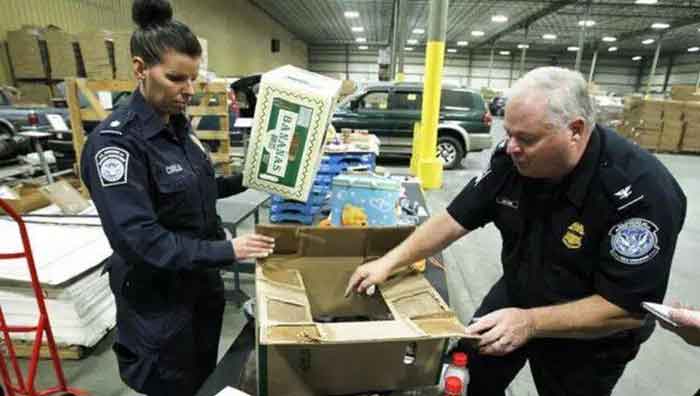Customs clearance can be daunting for global importers and may take a long time to learn. This guide aims to help you navigate the customs process more effectively and avoid customs clearance delays.
Additionally, it provides you with the necessary knowledge to ask the right questions when communicating with your customs broker or logistics provider.
What is the customs clearance process?
In addition to the needed shipping documents, importers should submit a customs entry form within five days of the goods’ arrival at a USA port.
This document is crucial for clearing goods through customs and typically includes details such as:
- HS code
- Country of origin
- Expected customs duties
- Description of imported goods
- Cost, Insurance, and Freight value
Depending on the value of the imported goods, each shipment will fall into one of three categories:
- Formal entries: Apply to commercial shipments valued at $2,500 or more.
- Informal entries: Apply to commercial or personal items valued at less than $2,500.
- De minimis threshold: Goods below $800 are exempt from duties and taxes.
Furthermore, importers must also prepare an Imported Security Filing (ISF) for all ocean cargo entering the US before it leaves the origin.
Once customs clearance is obtained, a freight forwarder issues a Delivery Order to the carrier, which initiates the delivery of goods from the port of arrival to the specified location.
For a more detailed customs process, please refer to our article:
How to do proper customs clearance?
When engaging a customs broker, you need to authorize them with a Power of Attorney, allowing them to act on your behalf as an importer.
For formal entries and containerized ocean shipping, importers should secure surety bonds to cover duties owed. There are generally two types of customs bonds:
- Single Bond: Obtained for each shipment.
- Continuous Bond: Automatically renewed, encompassing all shipments throughout the year.
To delve deeper into customs bonds, consider exploring the following article:
How long does customs clearance take?
The customs clearance process is typically swift if all preparations are in order, with products clearing customs within a day.
However, if your documentation is lacking, it could lead to several days of clearance delays. Moreover, if cargo fails to meet customs regulations after undergoing random inspection, it may be held by authorities, which will cause delays of 1-3 weeks.
Therefore, keep reading to discover how to minimize customs clearance delays and ensure the timely delivery of your products to their destination.

What causes customs clearance delays and how to avoid them?
1. Improper or insufficient documentation
Approximately 80% of customs delays stem from missing or incomplete documentation or inaccurate descriptions. Typical mistakes include:
- Poor product description
- Incorrect product codes
- Misuse of Harmonized Tariff Code(HS Code)
- Absence of commercial invoice
- Failure to specify the currency
- Incomplete values and quantities of goods
2. Incomplete shipper or consignee details
Incomplete or inaccurate names and addresses can cause delays as carriers must ascertain how to handle the shipment.
3. Unpaid taxes or charges
Outstanding fees or taxes can hold up shipments, especially for goods over $2500. Engaging a customs broker can expedite the process and potentially reduce costs compared to clearing customs independently.
4. Missing master file data
Providing carrier bond information, importer details, and Power of Attorney in advance is crucial. This step, often overlooked, is a common cause of customs delays.
5. Non-compliance with package and label rules
Some ports of entry have specific mandated packing and labeling requirements. Understanding and adhering to these regulations is critical to ensure the timely release of shipments.
Our Airsupply is here to help you streamline the customs clearance process. We provide customs brokerage services to handle all aspects of customs clearance on your behalf, from filing necessary paperwork to communicating with customs officials.
Furthermore, we ensure your shipments comply with all customs regulations and packing requirements, minimizing the risk of delays or penalties.
Common customs clearance issues
1. Customs classification errors
Understanding and correctly applying Harmonized codes is essential for seamless customs clearance. Research may be necessary to determine the appropriate designation for new or unfamiliar goods.
Misclassification can result in punitive duties imposed by Customs and Border Protection (CBP). If you are unsure about HS codes, you can send your cargo details to our shipping experts for assistance.
2. AD/CVD duties compliance
Anti-dumping and Countervailing Duties (AD/CVD) levied by U.S. regulators to address unfair trade practices, such as subsidized goods or goods sold below market value.
For example, steel subsidized by the Chinese government may be subject to anti-dumping tariffs to protect American producers.
Penalties for AD/CVD misclassification are severe, so it is crucial to double-check whether your cargo falls under AD/CVD regulations.
3. Intellectual Property Rights (IPR) violations
Importing goods with logos or trademarks requires documentation demonstrating legal authorization from suppliers.
Failure to provide proper licensing documentation for protected intellectual property may lead to the seizure, destruction, or return of goods. Additionally, you will assume all associated costs.
4. Inadequate documentation retention
It is essential to retain all import-related documents for at least five years. Documentation related to AD/CVD typically requires even longer retention periods.
Failure to produce these required documents can result in fines, duties, and penalties. For this, it is advisable to keep your records well-organized and readily accessible.
Successful customs clearance with ASLG
Failing to meet all requirements set by CBP can lead to costly delays and penalties. At Airsupply, we ensure you stay on top of your customs and duties obligations. Furthermore, we facilitate smooth shipping by including the option for customs clearance in your quote, giving you peace of mind.
People always ask:
Can I do customs clearance myself?
Yes, you can perform customs clearance on your own. However, this task requires a good understanding of the local customs laws, tariff codes, and basic paperwork. So, we recommend working with an experienced freight agent or customs broker to avoid customs delays and save costs.
Why is my package stuck in customs?
Packages can get stuck in customs for various reasons. Most commonly, these delays occur when customs officials cannot clear shipments due to potential safety concerns.
For instance, customs may hold the goods if you haven’t provided crucial certifications, such as safety or testing certificates, or if indispensable documentation, like an EORI number, is missing.
What should I do if my goods are stuck in customs?
If you think your package is held in customs, contact your freight forwarder to confirm the situation. Typically, freight forwarders assist in navigating the customs clearance process and can pinpoint any issues causing delays.




